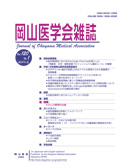

Journal of Okayama Medical Association
Published by Okayama Medical Association<Availability>
Full-text articles are available 3 years after publication.
Permalink : http://escholarship.lib.okayama-u.ac.jp/14027
ラットにおける DMH 誘発大腸癌株細胞 (RCN-9) を用いた肝転移モデル作成と実験化学療法 ―抗癌剤門脈内投与の効果について―
赤在 義浩
岡山大学医学部第一外科学教室
発行日
1993
抄録
To establish an effective chemotherapy against liver metastases, we compared the anti-proliferative effects of portal vein drug administration with that of intravenous administration, using a rat hepatic micrometastasis model. The model was produced by inoculating 1,2-dimethyl hydrazine (DMH)-induced rat colonic carcinoma (RCN-9) cells into the portal vein. The drugs used were 5-fluorouracil (5-FU), mitomycin-C (MMC) and cisdiammine-dichloroplatinum (CDDP), at total doses of 150mg/kg, 6mg/kg and 8mg/kg, respectively. Animals were classified into three groups in terms of drug administration times ; one time administration 2 days after tumor cell inoculation (day 2), three times on days 2, 9 and 16, and daily for fifteen days between day 2 and day 16. On day 21 after inoculation of the tumor cells, all rats were sacrificed and metastatic nodules were calculated. Portal vein administration of anticancer drugs, 5-FU, MMC, CDDP, had a tendency to inhibit the proliferation of liver micrometastases and was accompanied by fewer side effects, in comparison with intravenous infusion. In addition, significant prolongation of survival was achieved in the portal vein infusion group. These results suggest that intraportal administration of drugs is an effective modality to inhibit micro or occult liver metastases.
キーワード
大腸癌肝転移
動物モデル
微小肝転移
抗癌剤門脈内投与
ISSN
0030-1558
NCID
AN00032489
